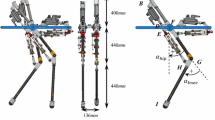Abstract
This paper addresses a new variable stiffness actuator (VSA) of a walking robot in a stance that can actively regulate a spring preload through correlation between spring reaction forces and joint variables. Here, VSA aims to realize energy-efficient stance motion of robotic limbs system from changing working conditions of a walking robot. Compared to conventional spring-loaded structures, it can effectively control both a spring stiffness and a spring-clamping configuration on humanoid’s lower body responding on uncertainties. ADAMS / MATLAB co-simulation system and experiments on the proposed VSA system as an active torque compensator are investigated for realizing energy-efficient motion in a robot’s stance.
Similar content being viewed by others
References
G. A. Pratt and M. M. Williamson, Series elastic actuators, IEEE/RSJ International Conference on Intelligent Robots and Systems, Pittsburg, Pennsylvania, USA (1995) 399–406.
D. W. Robinson, J. E. Pratt, D. J. Paluska and G. A. Pratt, Series elastic actuator development for a biomimetic walking robot, IEEE/ASME International Conference on Advanced Intelligent Mechatronics, Atlanta, Georgia, USA (1999) 561–568.
D. Lahr, H. Yi and D. Hong, Biologically inspired design of a parallel actuated humanoid robot, Advanced Robotics, 30 (2) (2016) 109–118.
D. Accoto, G. Carpino, F. Sergi, N. L. Tagliamonte, L. Zollo and E. Guglielmelli, Design and characterization of a novel high–power series elastic actuator for a lower limb robotic orthosis, International Journal of Advanced Robotic Systems, 10 (10) (2013) 1–12.
J. H. Yoo, M. W. Hyun, J. H. Choi, S. C. Kang and S. J. Kim, Optimal design of a variable stiffness joint in a robot manipulator using the response surface method, Journal of Mechanical Science and Technology, 23 (2009) 2236–2243.
H. Vallery, J. Veneman, E. V. Asseldonk, R. Ekkelenkamp, M. Buss and H. V. D. Kooij, Compliant actuation of rehabilitation robots: Benefits and limitations of series elastic actuators, IEEE Robotics & Automation Magazine, 15 (3) (2008) 60–69.
E. J. Rouse, L. M. Mooney and H. M. Herr, Clutchable series–elastic actuator: Implications for prosthetic knee design, The International Journal of Robotics Research, 33 (13) (2014) 1–15.
C. Knabe, B. Lee, V. Orekhov and D. Hong, Design of acompact, lightweight, electromechanical linear series elastic actuator, Proceedings of the ASME International Design Engineering Technical Conferences & Computers and Information in Engineering Conference, Buffalo, New York, USA (2014) 1–8.
N. Paine and L. Sentis, A new prismatic series elastic actuator with compact size and high performance, IEEE International Conference on Robotics and Biomimetics, Guangzhou, China (2012).
S. Wolf et al., Variable stiffness actuators: Review on design and components, IEEE/ASME Transactions on Mechatronics, 21 (5) (2016) 2418–2430.
B. S. Kim and J. B. Song, Hybrid dual actuator unit: A design of a variable stiffness actuator based on an adjustable moment arm mechanism, Proceedings of the IEEE International Conference on Robotics & Automation, Anchorage, Alaska, USA (2010) 1655–1660.
K. Nam, B. Kim and J. Song, Compliant actuation of parallel–type variable stiffness actuator based on antagonistic actuation, Journal of Mechanical Science and Technology, 24 (11) (2010) 2315–2321.
B. Vanderborght et al., Variable impedance actuators: A review, Robotics and Autonomous Systems, 61 (12) (2013) 1601–1614.
Author information
Authors and Affiliations
Corresponding authors
Additional information
Recommended by Editor Ja Choon Koo
Junghwan Yun received his B.S. and M.S. degrees in the Department of Mechanical Engineering from Kyungpook National University, Korea in 2016 and 2018, repectively. His research interests are design and control of the robotic system.
Hak Yi received his B.S. (2005) and M.S.(2008) degrees in the Department of Mechanical Engineering from Chonbuk National University and Ph.D. at Texas A&M University (2012). His research interests are design and control of robotic system. Currently He is an Assistant Professor in the School of Mechanical Engineering at Kyungpook National University since 2016.
Sangryong Lee received his B.S. degree (1980) and M.S. degree (1982) from the Department of Mechanical Engineering at Seoul National University and at KAIST, respectively. He received his Ph.D. degree in the Department of Mechanical Engineering from Georgia Institute of Technology, U.S.A. in 1989. Currently, he is a Professor of the School of Mechanical Engineering at Kyungpook National University. His research interests are design and control of mobile robots, intelligent systems and automation.
Rights and permissions
About this article
Cite this article
Yun, J., Yi, H. & Lee, S. Torque-compensation for energy-efficient motion of robotic limbs in a stance. J Mech Sci Technol 32, 5907–5912 (2018). https://doi.org/10.1007/s12206-018-1141-5
Received:
Revised:
Accepted:
Published:
Issue Date:
DOI: https://doi.org/10.1007/s12206-018-1141-5




